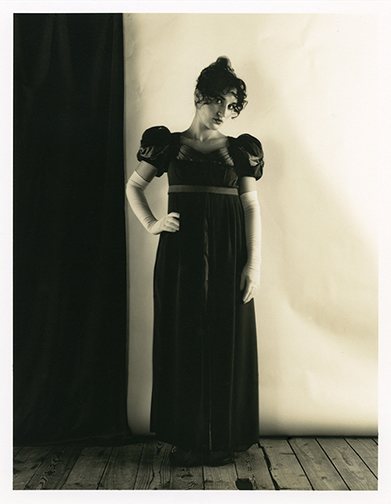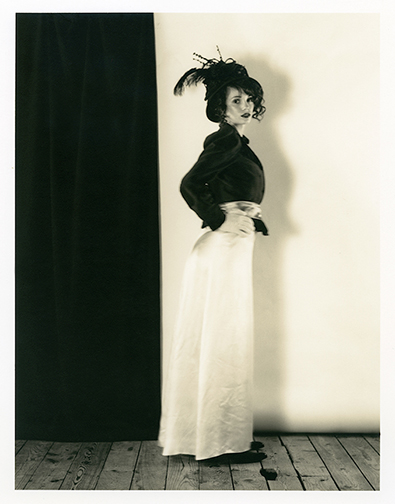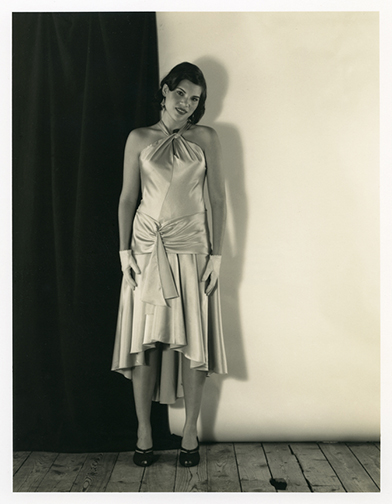 “1800: The Changing Erotic Zones” (EMH) Gowns were worn with undergarments, but the corset was almost given up. "The vertical silhouette emphasized the bosom and de-emphasized the waist" according to Valerie Steele. The narrowness and lightness of the fabric hinted the legs, while the ankle was fully revealed and became the erotic focus.
“1800: The Changing Erotic Zones” (EMH) Gowns were worn with undergarments, but the corset was almost given up. "The vertical silhouette emphasized the bosom and de-emphasized the waist" according to Valerie Steele. The narrowness and lightness of the fabric hinted the legs, while the ankle was fully revealed and became the erotic focus. “1805: The Changing Erotic Zones” (Haley Friesen) The skirt fell to touch the floor, but fabrics were much more revealing and diaphanous, usually white and often worn without undergarments. The high waistline emphasized the breasts which were often only loosely covered.
“1805: The Changing Erotic Zones” (Haley Friesen) The skirt fell to touch the floor, but fabrics were much more revealing and diaphanous, usually white and often worn without undergarments. The high waistline emphasized the breasts which were often only loosely covered. “1810: The Changing Erotic Zones” (Raquel Redmond) The "Empire" line continued with classical lines flowing over the female form, yet the return of undergarments, particularly the bosom-lifting caused the observer to concentrate on the breasts. Hemlines again exposed thee ankles and feet.
“1810: The Changing Erotic Zones” (Raquel Redmond) The "Empire" line continued with classical lines flowing over the female form, yet the return of undergarments, particularly the bosom-lifting caused the observer to concentrate on the breasts. Hemlines again exposed thee ankles and feet. “1815: The Changing Erotic Zones” (Aurelia) The outline of the dress continued with high waist, but fabrics were more concealing of waist and legs; hems dropped with details added to lower dress to draw eyes away from the upper form.
“1815: The Changing Erotic Zones” (Aurelia) The outline of the dress continued with high waist, but fabrics were more concealing of waist and legs; hems dropped with details added to lower dress to draw eyes away from the upper form. “1820: The Changing Erotic Zones” (Tricia Khutoretsky) The waistline was dropped to just above the natural line, this brought emphasis to the corseted waist for the first time in three decades. Skirts were wider and held away from the body with multiple petticoats and this also drew attention to the narrow waist.
“1820: The Changing Erotic Zones” (Tricia Khutoretsky) The waistline was dropped to just above the natural line, this brought emphasis to the corseted waist for the first time in three decades. Skirts were wider and held away from the body with multiple petticoats and this also drew attention to the narrow waist. “1825: The Changing Erotic Zones” (Lisa Marie Hoffmann) The waistline has found it's natural place, it is corseted tightly. Even greater emphasis is called to the narrowness by increasing the upper sleeve size with puffs to create an upper cone-shape equal to the lower inverted cone of the skirt.
“1825: The Changing Erotic Zones” (Lisa Marie Hoffmann) The waistline has found it's natural place, it is corseted tightly. Even greater emphasis is called to the narrowness by increasing the upper sleeve size with puffs to create an upper cone-shape equal to the lower inverted cone of the skirt. “1830: The Changing Erotic Zones” (Roksy) Once again the skirt length is raised above the ankle to allow glimpses of the lower leg. Sleeves have increased in upper-arm girth and the expanse of upper bodices cover the breasts while at the same time calling attention to the area and emphasizing the comparatively small waist.
“1830: The Changing Erotic Zones” (Roksy) Once again the skirt length is raised above the ankle to allow glimpses of the lower leg. Sleeves have increased in upper-arm girth and the expanse of upper bodices cover the breasts while at the same time calling attention to the area and emphasizing the comparatively small waist. “1835: The Changing Erotic Zones” (Becca Cooke) This fashion was even more exaggerated in sleeves and skirt width; hoops of horsehair (crinolines) created a very wide skirt, but left the legs to be glimpsed with only stockings to cover as wind or movement tipped up the skirts.
“1835: The Changing Erotic Zones” (Becca Cooke) This fashion was even more exaggerated in sleeves and skirt width; hoops of horsehair (crinolines) created a very wide skirt, but left the legs to be glimpsed with only stockings to cover as wind or movement tipped up the skirts. “1840: The Changing Erotic Zones” (Genevieve) Suddenly the enormous shoulders and puffed sleeves gave way to a narrower upper silhouette with softer natural shoulders and fullness of sleeves dropping to the lower arm. Bodices were corseted at the natural waist with ever widening skirts below to bring the eyes to the waist.
“1840: The Changing Erotic Zones” (Genevieve) Suddenly the enormous shoulders and puffed sleeves gave way to a narrower upper silhouette with softer natural shoulders and fullness of sleeves dropping to the lower arm. Bodices were corseted at the natural waist with ever widening skirts below to bring the eyes to the waist. “1845: The Changing Erotic Zones” (Nkaunaag) This is the point where the foot disappears under the floor-length skirts, not to appear again for fifty years. The torso is tightly corseted which continues to emphasize the waist as the erogenous zone. Sleeves have narrowed further, which calls attention to the arms which despite being completely covered do show their anatomy.
“1845: The Changing Erotic Zones” (Nkaunaag) This is the point where the foot disappears under the floor-length skirts, not to appear again for fifty years. The torso is tightly corseted which continues to emphasize the waist as the erogenous zone. Sleeves have narrowed further, which calls attention to the arms which despite being completely covered do show their anatomy. “1850: The Changing Erotic Zones” (Amber Major) Skirts are embellished with decoration and remain the focus of attention by covering and yet reminding the viewer of what is underneath. Evening gowns show daring decolletage while day dresses are demure.
“1850: The Changing Erotic Zones” (Amber Major) Skirts are embellished with decoration and remain the focus of attention by covering and yet reminding the viewer of what is underneath. Evening gowns show daring decolletage while day dresses are demure. “1855: The Changing Erotic Zones” (Laura Helde) Crinolines continue to create a completely circular silhouette with waist tightly nipped. Fabrics are heavy and dark colors conceal the body while creating an "civilized erotic charge" according to Austrian writer Robert Musil.
“1855: The Changing Erotic Zones” (Laura Helde) Crinolines continue to create a completely circular silhouette with waist tightly nipped. Fabrics are heavy and dark colors conceal the body while creating an "civilized erotic charge" according to Austrian writer Robert Musil. “1860: The Changing Erotic Zones” (Brenna) The roundness of the skirt silhouette begins to sweep into an oval shape with emphasis beginning to switch to the back of the body. Skirt decoration has declined, but bell-shaped sleeves have caught attention to the upper torso again, while still concealing every square inch of skin but the face of the wearer.
“1860: The Changing Erotic Zones” (Brenna) The roundness of the skirt silhouette begins to sweep into an oval shape with emphasis beginning to switch to the back of the body. Skirt decoration has declined, but bell-shaped sleeves have caught attention to the upper torso again, while still concealing every square inch of skin but the face of the wearer. “1865: The Changing Erotic Zones” (Sequoya A.) The skirt has reached its most exaggerated shape with the oval increasingly calling attention to the rear. Arms were displayed in their natural shape whether covered or bare (for evening with gloves). Hints of what was beneath were becoming more obvious.
“1865: The Changing Erotic Zones” (Sequoya A.) The skirt has reached its most exaggerated shape with the oval increasingly calling attention to the rear. Arms were displayed in their natural shape whether covered or bare (for evening with gloves). Hints of what was beneath were becoming more obvious. “1870: The Changing Erotic Zones” (Linda X.) The bustle has arrived as all emphasis shifted directly to the buttocks. Skirts narrowed with fabric pulled back to cover the cage over the derriere trailing to a short train at the back. Sleeves were narrow and frontal decoration was at a minimum.
“1870: The Changing Erotic Zones” (Linda X.) The bustle has arrived as all emphasis shifted directly to the buttocks. Skirts narrowed with fabric pulled back to cover the cage over the derriere trailing to a short train at the back. Sleeves were narrow and frontal decoration was at a minimum. “1875: The Changing Erotic Zones” (Phoua Lor) The bodice has continued tightly corseted, sleeves remain narrow and the primary emphasis is the dress's bustled back. The lines are softer and somewhat lower than the waist which only emphasizes the buttocks natural shape.
“1875: The Changing Erotic Zones” (Phoua Lor) The bodice has continued tightly corseted, sleeves remain narrow and the primary emphasis is the dress's bustled back. The lines are softer and somewhat lower than the waist which only emphasizes the buttocks natural shape. “1880: The Changing Erotic Zones” (Edith J.) All the decoration is at the back, the bustle is at hip height with fabric flowing into an exaggerated train, calling attention to the legs which are tightly concealed. The bodice is elongated to increase the effect of the leg outline.
“1880: The Changing Erotic Zones” (Edith J.) All the decoration is at the back, the bustle is at hip height with fabric flowing into an exaggerated train, calling attention to the legs which are tightly concealed. The bodice is elongated to increase the effect of the leg outline. “1885: The Changing Erotic Zones” (Cecily Amrane) The bustle rises to waist height again, the skirts sweep upward off the floor and the torso front is again back to natural waist. The narrow sleeves and tight torso style once again call attention to the breasts.
“1885: The Changing Erotic Zones” (Cecily Amrane) The bustle rises to waist height again, the skirts sweep upward off the floor and the torso front is again back to natural waist. The narrow sleeves and tight torso style once again call attention to the breasts. “1890: The Changing Erotic Zones” (Aysha Stanger) The bustle is gone. Dresses have been replaced with skirts with simple gored A-line shapes and blouses for girls and women who are looking for easy-care garments. Sports and exercise have gained popularity for day wear. Evening dress remains elegant with deep decolletage and beautiful fabrics.
“1890: The Changing Erotic Zones” (Aysha Stanger) The bustle is gone. Dresses have been replaced with skirts with simple gored A-line shapes and blouses for girls and women who are looking for easy-care garments. Sports and exercise have gained popularity for day wear. Evening dress remains elegant with deep decolletage and beautiful fabrics. “1895: The Changing Erotic Zones” (Jeanie Larsen) Suddenly the corset has changed shape and created the S-curve with its straight front and exaggerated pelvic tilt. The chest is thrust forward in a pouter-pigeon look; sleeves are widely puffed to create a top-heavy silhouette while the skirt is widened to match, but with petticoats not hoops.
“1895: The Changing Erotic Zones” (Jeanie Larsen) Suddenly the corset has changed shape and created the S-curve with its straight front and exaggerated pelvic tilt. The chest is thrust forward in a pouter-pigeon look; sleeves are widely puffed to create a top-heavy silhouette while the skirt is widened to match, but with petticoats not hoops. “1900: The Changing Erotic Zones” (Sabelle) The s-curve corset remains in vogue, skirts are narrower and the mono-bosom is the shape decreed by the fashion forward, breasts are disguised with puffy bloused fronts, while the buttocks are once again emphasized.
“1900: The Changing Erotic Zones” (Sabelle) The s-curve corset remains in vogue, skirts are narrower and the mono-bosom is the shape decreed by the fashion forward, breasts are disguised with puffy bloused fronts, while the buttocks are once again emphasized. “1905: The Changing Erotic Zones” (Jennifer Adriene Burks) The silhouette becomes stronger with the broader shoulders defining feminine power. The suffrage movement is gaining adherents and bicycles have given females ability to move independently.
“1905: The Changing Erotic Zones” (Jennifer Adriene Burks) The silhouette becomes stronger with the broader shoulders defining feminine power. The suffrage movement is gaining adherents and bicycles have given females ability to move independently. “1910: The Changing Erotic Zones” (JennaLee) The mono-bosom look is softened by allowing natural shoulder and waist definition. Narrow skirt restricts stride to a mincing gait which gives wearers a hobbled manner of walking.
“1910: The Changing Erotic Zones” (JennaLee) The mono-bosom look is softened by allowing natural shoulder and waist definition. Narrow skirt restricts stride to a mincing gait which gives wearers a hobbled manner of walking. “1915: The Changing Erotic Zones” (Tay Sky) The ankle is revealed! The narrow skirt is suggestive that legs are attached and the torso is understated.
“1915: The Changing Erotic Zones” (Tay Sky) The ankle is revealed! The narrow skirt is suggestive that legs are attached and the torso is understated. “1920: The Changing Erotic Zones” (Trisha J.) Where to look first? Suddenly the legs are revealed, often to above the knees, which become the exciting zone. Skirts are loose to flip from the dropped waist and upper arms may also be uncovered to show a sleeveless arms-eye. Bobbed hair is covered with a cloche but is loose when indoors; freedom is in the air.
“1920: The Changing Erotic Zones” (Trisha J.) Where to look first? Suddenly the legs are revealed, often to above the knees, which become the exciting zone. Skirts are loose to flip from the dropped waist and upper arms may also be uncovered to show a sleeveless arms-eye. Bobbed hair is covered with a cloche but is loose when indoors; freedom is in the air. “1925: The Changing Erotic Zones” (Rosimar) Breasts have been bound to the chest and emphasis is on the lowered waistline; hair was cut to a "bob" at ear length or higher to achieve a "boyish look."
“1925: The Changing Erotic Zones” (Rosimar) Breasts have been bound to the chest and emphasis is on the lowered waistline; hair was cut to a "bob" at ear length or higher to achieve a "boyish look."  “1930: The Changing Erotic Zones” (Alice Piar) following directly from the "boyish look" of the twenties, femininity rushes back using bias cut fabrics to cling to the form and emphasize hips and often the curvaceous shoulders and bare back.
“1930: The Changing Erotic Zones” (Alice Piar) following directly from the "boyish look" of the twenties, femininity rushes back using bias cut fabrics to cling to the form and emphasize hips and often the curvaceous shoulders and bare back. “1935: The Changing Erotic Zones” (Hanah Lahl) The Great Depression is alleviated to a degree as women are seen in streamlined and no-nonsense tailored suits. Skirts skim the hips and just cover the knees. Stockings have eye-catching seams at back center to draw the view upward to the derriere.
“1935: The Changing Erotic Zones” (Hanah Lahl) The Great Depression is alleviated to a degree as women are seen in streamlined and no-nonsense tailored suits. Skirts skim the hips and just cover the knees. Stockings have eye-catching seams at back center to draw the view upward to the derriere. “1940: The Changing Erotic Zones” (Kristine Labbe) Wartime restrictions regulated fabric use, but designers produced distinctly feminine garments to contrast with the drab utilitarian "Rosie the Riveter" look worn by day as women took factory and industrial jobs.
“1940: The Changing Erotic Zones” (Kristine Labbe) Wartime restrictions regulated fabric use, but designers produced distinctly feminine garments to contrast with the drab utilitarian "Rosie the Riveter" look worn by day as women took factory and industrial jobs. “1945: The Changing Erotic Zones” (Arden) World War II had influenced everything in fashion for women, rationing and patriotism dictated narrow skirts and simple designs. Hair, hats and shoes provided contrast with tailored details at shoulders to provide an updated look.
“1945: The Changing Erotic Zones” (Arden) World War II had influenced everything in fashion for women, rationing and patriotism dictated narrow skirts and simple designs. Hair, hats and shoes provided contrast with tailored details at shoulders to provide an updated look. Caption goes here






























